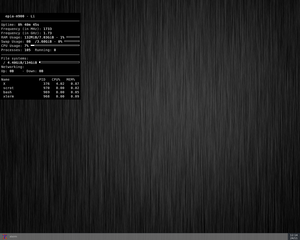Kwort Linux
Kwort is a Linux distribution, based on CRUX.[2][5] Kwort's desktop environment is Openbox.[1]
 Kwort Linux 4.3.4 | |
| OS family | Linux (Unix-like) |
|---|---|
| Working state | Current |
| Source model | Open source |
| Initial release | 22 January 2006[1] |
| Latest release | 4.3.4[2][3] / 16 June 2019 |
| Package manager | kpkg[4] |
| Platforms | x86-64[1] |
| Default user interface | Openbox[1] |
| Official website | kwort |
Installation
The distribution is available for download as installation-only CD image suitable for x64-based computers.[6] It does not provide installation program. Instead, text-based applications and scripts are used to install and configure the system.[7] Contrary to CRUX Linux, the user doesn't need to compile a new kernel.
System requirements
The system requirements of Kwort are:[8]
Package manager
Kwort Linux uses the kpkg package manager.[2][9] kpkg can download and install packages from Kwort's or third party repositories and their mirrors.
Reception
Tux Machines reviewed Kwort Linux in March 2006.[10] The review included the following:
Not long after booting the install cd I became aware that Kwort is based on Slackware. They use a slightly simplified Slackware installer. Basically, only the target partition is asked before the install begins and then it installs a base system. After which it asks about your dial-up modem, network configuration, and lilo choices. Upon boot, it walks the user through the configuration of alsa, root password, and a user account before it asks for the install cd again.
Jesse Smith wrote a review of Kwort 4.3 for DistroWatch Weekly:[7]
The installation instructions let us know that we will need to do a bit of manual work to get a fresh copy of Kwort up and running. At times the instructions are sparse and I recommend reading the on-line copy of the installation guide as it fills in some of the blanks. Kwort does not have a system installer and so we find ourselves using command line utilities to partition the hard drive, format disk partitions and mount the areas of the disk where we plan to install the distribution. We then run a command called "pkgsinstall" which copies the base operating system onto our waiting hard drive. We then need to manually edit our fstab file and the system's configuration file, rc.conf, to make sure it has our correct keyboard layout and time zone. Another command sets the root password. Next, we need to decide which boot loader to install (LILO or GRUB), along with supporting packages, and run commands to install the boot loader and configure it. Again, the installation steps are a bit vague here and I recommend visiting the on-line documentation to see examples of how best to proceed. Assuming we successfully get a boot loader installed we can then reboot the computer and begin exploring Kwort.
External links
References
- DistroWatch.com: Kwort Linux
- Kwort Linux | HomePage
- Distribution Release: Kwort Linux 4.3.4 (DistroWatch.com News)
- kpkg repository on GitHub
- Kwort Linux 4.2 Is a Fast and Clean CRUX Distribution Powered by Linux Kernel 3.19.2, Softpedia News.
- Distribution Release: Kwort Linux 4
- DistroWatch Weekly, Issue 644, 18 January 2016
- Install Documentation
- Kwort Linux | Package System
- Introducing Kwort Linux | Tux Machines